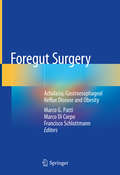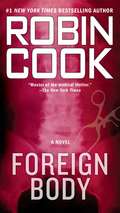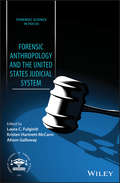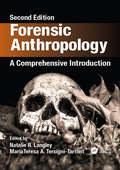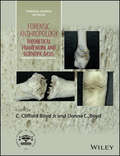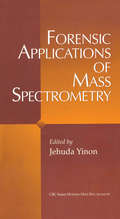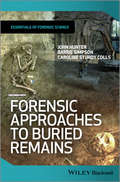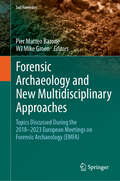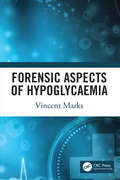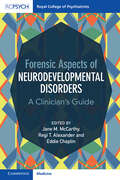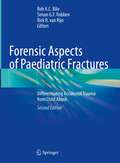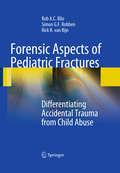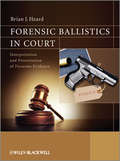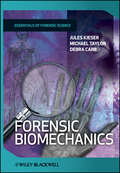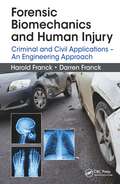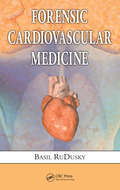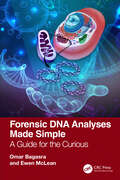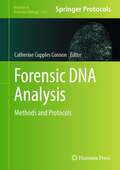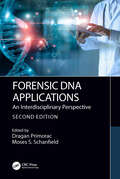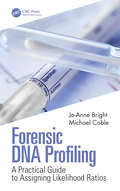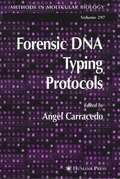- Table View
- List View
Foregut Surgery: Achalasia, Gastroesophageal Reflux Disease and Obesity
by Marco G. Patti Francisco Schlottmann Marco Di CorpoThis book provides a state-of-the-art description of the clinical evaluation, diagnosis, management, and treatment of achalasia, gastroesophageal reflux disease, paraesophageal hernia, and morbid obesity. The prevalence of such diseases is increasing worldwide due to higher awareness and improved diagnosis rate. The text is divided in three different parts, each covering detailed surgical techniques of the main foregut operations: achalasia, gastroesophageal reflux disease (GERD), and obesity. Written by experts in the field, chapters focus on the preoperative work-up, indications, and technical aspects of each operation. Foregut Surgery proves to be an irreplaceable resource for surgeons, gastroenterologists, medical students, and surgical residents that care for patients with reflux, achalasia, and morbid obesity.
Foreign Body
by Robin CookIn this chilling new novel from the one and only Robin Cook, New York City medical examiners Laurie Montgomery and Jack Stapleton rush to India to help a UCLA student investigating medical tourism-and a sinister global conspiracy.
Foreign Body (Jack Stapleton / Laurie Montgomery #8)
by Robin CookJennifer Hernandez is a fourth-year medical student at UCLA, just beginning an elective in general surgery, whose world is shattered during a break in an otherwise ordinary day. While relaxing in the surgical lounge of L.A."s Cedars-Sinai Medical Center, she half listens to a TV segment on medical tourism: first-world citizens traveling to third-world countries for surgery. But when she hears her beloved grandmother's name mentioned, Jennifer's heart nearly stops: the CNN reporter says that Maria Hernandez has died, a day after undergoing a hip replacement in New Delhi's Queen Victoria Hospital. Maria had raised Jennifer and her brothers from infancy, and the bond between grandmother and granddaughter was unbreakable. Still, the news that Maria traveled to India is a shock to Jennifer, until she realizes that it was the only viable option for the hardworking yet uninsured woman. Devastated, and desperate for answers, Jennifer takes emergency leave from school and heads to India, where relations with local officials go from sympathetic to sour as she pushes for more information. With revelations of other unexplained deaths compounded by pressure from Indian hospital officials for hasty cremations, Jennifer reaches out to her mentor, New York City medical examiner Dr. Laurie Montgomery, who has her own deep connection to Maria. Laurie, along with her husband, Dr. Jack Stapleton, rushes to the younger woman's side, and discovers a sophisticated medical facility with little margin for error. As the death count grows, so do the questions, leading Laurie and Jennifer to unveil a sinister, multilayered conspiracy of global proportions.
Forensic Analysis of Fire Debris and Explosives
by Kenyon Evans-Nguyen Katherine HutchesThis text provides training on the fundamental tools and methodologies used in active forensic laboratories for the complicated analysis of fire debris and explosives evidence. It is intended to serve as a gateway for students and transitioning forensic science or chemistry professionals. The book is divided between the two disciplines of fire debris and explosives, with a final pair of chapters devoted to the interplay between the two disciplines and with other disciplines, such as DNA and fingerprint analysis. It brings together a multi-national group of technical experts, ranging from academic researchers to active practitioners, including members of some of the premier forensic agencies of the world. Readers will gain knowledge of practical methods of analysis and will develop a strong foundation for laboratory work in forensic chemistry. End-of-chapter questions based on relevant topics and real-world data provide a realistic arena for learners to test newly-acquired techniques.
Forensic Anthropology and the United States Judicial System (Forensic Science in Focus)
by Alison Galloway Laura C. Fulginiti Kristen Hartnett-McCannA guide to the interface between forensic anthropology and the United States legal system Designed for forensic anthropologists at all levels of expertise, Forensic Anthropology and the United States Judicial System offers a comprehensive examination of how to effectively present osteological analyses, research and interpretations in the courtroom. Written by noted experts, the book contains an historical perspective of the topic, a review of current legislation that affects expert testimony as well as vital information on courtroom procedure and judicial expectation of experts. A comprehensive book, Forensic Anthropology and the United States Judicial System explains how to prepare case reports and offers suggestions for getting ready for pre-trial interviews. The book also includes detailed information on affidavits, fee structures and dealing with opposing experts. This book is part of the popular Wiley – American Association for Forensic Sciences series and: Offers a unique volume that addresses the interface between forensic anthropology and the legal system Contains detailed guidelines for expert testimony by forensic anthropologists with all levels of experience, from beginner to expert Includes information from the perspective of the Judiciary in terms of process and expectations of the Court Shows how to maintain independence from, and collaborate with other experts Presents detailed explanations of current legislation impacting forensic science Forensic Anthropology and the United States Judicial System is an information-filled guide for practitioners of the rapidly growing field that integrates forensic sciences and the judicial system.
Forensic Anthropology: A Comprehensive Introduction, Second Edition
by Natalie R. Langley MariaTeresa A. Tersigni-TarrantThis robust, dynamic, and international field has grown to include interdisciplinary research, continually improving methodology, and globalization of training. Reflecting the diverse nature of the science from experts who have shaped it, Forensic Anthropology: A Comprehensive Introduction Second Edition builds off of the success of the first edition and incorporates standard practices in addition to cutting-edge approaches in a user-friendly format, making it an ideal introductory-level text.
Forensic Anthropology: A Comprehensive Introduction, Second Edition
by Natalie R. Langley MariaTeresa A. Tersigni-TarrantThis robust, dynamic, and international field has grown to include interdisciplinary research, continually improving methodology, and globalization of training. Reflecting the diverse nature of the science from experts who have shaped it, Forensic Anthropology: A Comprehensive Introduction Second Edition builds off of the success of the first edition and incorporates standard practices in addition to cutting-edge approaches in a user-friendly format, making it an ideal introductory-level text.
Forensic Anthropology: Theoretical Framework and Scientific Basis
by C. Clifford Boyd Jr. Donna C. BoydProvides comprehensive coverage of everything that students and practitioners need to know about working in the field of forensic anthropology Forensic anthropology has been plagued by questions of scientific validity and rigor despite its acceptance as a section in the American Academy of Forensic Sciences nearly half a century ago. Critics have viewed it as a laboratory-based applied subfield of biological anthropology, and characterised it as emphasising methodology over theory. This book shows that these views are not only antiquated, but inadequate and inaccurate. Forensic Anthropology: Theoretical Framework and Scientific Basis introduces readers to all of the theoretical and scientific foundations of forensic anthropology — beginning with how it was influenced by the early theoretical approaches of Tyler, Morgan, Spencer and Darwin. It instructs on how modern forensic science relies on an interdisciplinary approach — with research being conducted in the fields of archaeology, physics, geology and other disciplines. This modern approach to theory in forensic anthropology is presented through the introduction and discussion of Foundational, Interpretive and Methodological theories. Sections cover: Bias and Objectivity in Forensic Anthropology Theory and Practice; The Theory and Science Behind Biological Profile and Personal Identification; Scientific Foundation for Interpretations of Antemortem, Perimortem, and Postmortem Processes; and Interdisciplinary Influences, Legal Ramifications and Future Directions. Illustrates important aspects of the theory building process and reflects methods for strengthening the scientific framework of forensic anthropology as a discipline Inspired by the “Application of Theory to Forensic Anthropology” symposium presented at the 67th annual meeting of the American Academy of Forensic Sciences Chapters written by experts in the field who were presenters at the symposium Forensic Anthropology: Theoretical Framework and Scientific Basis is ideal for university courses in anthropological science, forensic science, criminal science and forensic archaeology.
Forensic Applications of Mass Spectrometry
by Jehuda Yinon Werner A. Baumgartner Wolfgang Bertsch Jean Louis Brazier Chen-Chih Cheng Bongchul Chung John T. Cody Thomas D. Donahue Dean D. Fetterolf Rodger L. Foltz Gene F. Hayes Virginia A. Hill Gunther Holzer Dongseok Lho Thomas O. Munson Jongsei Park Songja Park Henry ScholtzForensic Applications of Mass Spectrometry combines the most current developments in applications of mass spectrometry techniques to forensic analyses. The techniques discussed include:capillary-GC/MSthermospray-LC/MStandem mass spectrometry (MS/MS)pyrolysis-GC/MSisotope ratio mass spectrometryThe applications include:analysis of body fluids and hair for drugs of abusedrug testing in sportsanalysis of accelerants in fire debrisdetection of hidden explosives in luggage and mailidentification of explosives in post-explosion debrisexamination of evidential materials (paints, fibers, synthetic polymers)authentication of regulated products (flavoring substances, fruit juices)protection of industrial products by isotopic signature
Forensic Approaches to Buried Remains
by John Hunter Caroline Sturdy Colls Barrie SimpsonThe field of forensic archaeology has developed over recent years from being a branch of conventional archaeology into a well-established discipline in its own right. Forensic Approaches to Buried Remains takes an innovative approach to the subject by placing the role of the forensic archaeologist within the wider forensic environment; it identifies new areas of interdisciplinary research and practice, and evaluates practical difficulties.The authors see this book as a reflection of the subject's development, and as a knowledge base for the next generation of forensic archaeologists. Areas covered include:Search logistics, integration and specialist search scenariosLevels of confidence in site search and eliminationUrban and rural landscape reconstruction in both short and long term casesThe integration of cadaver dogs and earth-moving machineryThe recovery of multiple evidence typesSampling strategies, spatial relevance and datingMultiple burial scenarios As part of the Essential Forensic Science book series this book will provide students and practitioners alike with an invaluable resource outlining both the major developments in the discipline, as well as original approaches to the search for, and recovery of buried remains.
Forensic Archaeology and New Multidisciplinary Approaches: Topics Discussed During the 2018-2023 European Meetings on Forensic Archaeology (EMFA) (Soil Forensics)
by Pier Matteo Barone Wj Mike GroenThis book presents the latest research and developments in forensic archaeology, as discussed at the European Meetings on Forensic Archaeology (EMFA) from 2018 to 2023. It captures the dynamic and multidisciplinary nature of the field, highlighting the challenges and innovations that have emerged over the last five years. Divided into three main parts, the book addresses critical aspects of forensic archaeology and its diverse applications. Part I on Forensic Archaeology from the Crime Scene explores cutting-edge methodologies and their application in various forensic contexts. Part II focuses on Forensic Anthropology and Humanitarian Investigations, presenting the study of human remains and the application of forensic archaeology in humanitarian contexts. The final part addresses Heritage Crimes and the role of forensic archaeology in investigating and preventing the illegal trade in artifacts and the destruction of cultural heritage sites. Contributions from both EMFA presenters and external experts provide a rich tapestry of theoretical advances and practical applications. This new volume is essential for forensic archaeologists, forensic scientists, law enforcement professionals, and scholars interested in the intersection of archaeology and forensic science. It serves as an important resource for those seeking to understand the complexities of forensic investigations.
Forensic Aspects of Hypoglycaemia: First Edition
by Vincent MarksThe Forensic Aspects of Hypoglycaemia succinctly covers the medicolegal considerations of hypoglycaemia in a variety of scenarios including driving fatalities, petty crime, homicide and suicide. Covering the definitions and diagnosis of hypoglycaemia to its bearing on criminal behavior, this book draws on the author's extensive experience and contains a wealth of information for physicians and lawyers, including cases from the author's past and notable cases in the public domain.
Forensic Aspects of Neurodevelopmental Disorders: A Clinician's Guide
by Eddie Chaplin Jane M. McCarthy Regi T. AlexanderEvidence has shown a high prevalence of neurodevelopmental disorders amongst offenders in custodial institutions. Bringing together the latest knowledge and understanding, this book describes the needs of offenders who present with neurodevelopmental disorders, including autism spectrum disorder, ADHD, intellectual disability and foetal alcohol spectrum disorders. The book covers aetiology, prevalence, comorbid mental disorders, legal issues, assessment including risk assessments, diagnosis and therapeutic approaches. It describes care pathways through the criminal justice system across the UK and internationally, including the current and ongoing developments of services for this group. With contributions from experts in the field including psychiatrists, researchers and psychologists, this book provides a comprehensive summary of the evidence whilst ensuring the focus is for the everyday clinician working in this area. It is an invaluable resource for psychiatrists and other professionals working across the criminal justice system and within forensic services.
Forensic Aspects of Paediatric Fractures: Differentiating Accidental Trauma from Child Abuse
by Rick R. van Rijn Rob A. C. Bilo Simon G. F. RobbenThis excellently illustrated book, now in a revised and extended second edition, not only describes the radiological findings which can be found in child abuse cases but also places them in a forensic perspective – a crucial aspect often underrepresented in radiological books. The aim is to enable physicians involved in non-accidental trauma cases to interpret radiological findings in light of the forensic circumstances under which these findings have arisen. Accordingly, the book will assist in determining whether a fracture is accidental or the result of abuse. Fractures are addressed not only by anatomical location but also by trauma mechanism, with careful attention to evidence regarding the reported mechanism and the clinical outcome. Drawing on the latest literature, the authors explain whether a particular form of trauma can cause a particular injury and identify where the reader can find the supporting evidence. The book will be essential reading and a superb reference for all who are involved in the diagnosis of child abuse, including pediatricians, emergency room physicians, and radiologists. It will also be a valuable resource for legal medicine physicians, lawyers, and judges.
Forensic Aspects of Pediatric Fractures
by Rick R. van Rijn Rob A. Bilo Simon G. RobbenFractures are a common finding in children and it is estimated that 2.1% of all children will suffer at least one fracture before the age of 16. With young children in particular, the question may arise if this is related to child abuse. The aim of this book is to help physicians involved in child abuse cases to interpret radiological findings in light of the forensic circumstances under which they occurred. The authors present up-to-date literature related to the mechanisms underlying non-accidental cases of trauma. In this book not only the radiological findings in child-abuse are discussed, but more importantly, these findings are analyzed from a forensic perspective. Careful attention is paid to evidence regarding reported trauma mechanisms and their clinical outcome; for example, can a fall from a couch result in a femoral fracture, and if not, where is the supporting evidence?
Forensic Ballistics in Court
by Brian J. HeardForensic Ballistics in Court: Interpretation and Presentation of Firearms Evidence is an accessible introduction to firearms and ballistics evidence and how this is analysed and presented as evidence in a court of law.The book approaches the subject in terms of the realities of case work, opening with a clear and illustrated explanation of the correct nomenclature for various weapon types and their parts. Ammunition is also extensively covered, again with annotated illustrations. Basic external and terminal ballistics, wounding capabilities are likewise covered to give an overview of the subject. A key aspect of the book covers the theory and philosophy behind striation matches and the associated statistics, how positive matches should be peer reviewed and the importance accreditation has on this subject.Gunshot residue formation and identification and the various methods used in its analysis are reviewed in depth. This includes a critical examination of the pros and cons of each type of examination and the evidential weight which can be applied to each method.Accessible and reader-friendly introduction to firearms and ballistics.Clarifies the limitations of firearms evidence.Extensive use of global case-studies throughout.Focus on the interpretation and assessment of the weight of firearms/ballistics evidence presented at court.Covers the importance of witness and accused statements and their interpretation in relation to the investigation under review.Includes coverage of gunshot residue collection, examination and interpretation and the potential for contamination of GSR samples.Includes numerous real life case studies that the author has dealt with over the past 45 years.Takes an applied approach to the subject.
Forensic Biomechanics
by Michael Taylor Jules Kieser Debra CarrBiomechanics is the application of mechanical principles to living organisms, and it is one of the most exciting and fastest growing research areas. In forensic science, it is biomechanics that explains trauma to the body at a crime scene or the fracture of fibers and textiles, and helps interpret blood spatter. Forensic Biomechanics is a comprehensive overview of the role of biomechanics in forensics. Well-illustrated with real-life case studies, and using a multidisciplinary approach, this unique book is an invaluable reference for practicing forensic scientists, lawyers, and researchers.
Forensic Biomechanics and Human Injury: Criminal and Civil Applications - An Engineering Approach
by Harold Franck Darren FranckForensic Biomechanics and Human Injury: Criminal and Civil Applications � An Engineering Approach provides a concise, comprehensive overview of human anatomy and the biomechanical factors involved in human injury. It describes the methodologies used to compute the various forces, stresses, and energies required to injure the human body.The book cov
Forensic Cardiovascular Medicine
by Basil RuDuskyAdvance Praise for Forensic Cardiovascular Medicine"Using his vast experience in the medical-legal theater, Dr. RuDusky addresses a very complicated field in a simple and concise manner. Stressing the importance of honesty, integrity, and accuracy of data, he provides an insightful and interesting approach to the problems facing today's medical com
Forensic DNA Analyses Made Simple: A Guide for the Curious
by Omar Bagasra Ewen McLeanSequencing genetic material is now common practice. The general population have become consumers of this information but without an understanding of the biological processes that render sequencing data useful. The interpretation of genetic sequence depends on an appreciation of the basics of genetics and the limits of such data. This book provides the background necessary to understand, interpret, and apply sequencing information to real- world problems. Replication of genetic material, the structure of DNA, typing methods, and forensic applications are all discussed in this useful primer. Key Features • Provides self-learning about DNA fingerprinting. • Includes sections on how to analyze and interpret DNA fingerprinting. • Covers legal and medicolegal issues and case analyses. • Teaches novice legal community about DNA fingerprints. • Summarizes for a general audience the role of ancestry, DNA, and what that means.
Forensic DNA Analysis: Methods and Protocols (Methods in Molecular Biology #2685)
by Catherine Cupples ConnonThis volume focuses on the latest techniques used in forensic DNA analysis. The chapters include a comprehensive collection of extraction, quantification, STR amplification, and detection methods for routine forensic samples, including manual, semi-automated, and automated procedures using both home-brew and commercial products. The chapters also discuss probabilistic modeling software and specialized start-to-finish procedures for mitochondrial DNA analysis, archived latent fingerprints, latent DNA, rapid DNA profiling, and next-generation sequencing. Written in the highly successful Methods in Molecular Biology series format, chapters include introduction to their respective topics, lists of the necessary materials and reagents, step-by-step, readily reproducible laboratory protocols, and tips on troubleshooting and avoiding known pitfalls.Cutting-edge and practical, Forensic DNA Analysis: Methods and Protocols is a valuable resource for researchers interested in learning more about forensic DNA analysis procedures.
Forensic DNA Applications: An Interdisciplinary Perspective
by Dragan Primorac and Moses S. SchanfieldForensic DNA Applications: An Interdisciplinary Perspective, Second Edition is fully updated to outline the latest advances in forensic DNA testing techniques and applications. It continues to fill the need for a reference book for people working in the field of forensic molecular biology testing and research as well as individuals investigating and adjudicating cases involving DNA evidence, whether they be civil or criminal cases. DNA techniques have greatly impacted obvious traditional forensic areas, but such advances have also positively affected myriad new areas of research and inquiry. It is possible today to think about solving forensic problems that were simply unheard of even a few years ago. As such, the book pulls all relevant research and applied science together into a detailed and comprehensive collection. Part I begins with the history and development of DNA typing and profiling for criminal and civil purposes. It discusses the statistical interpretation of results with case examples, mitochondrial DNA testing, Y single nucleotide polymorphisms (SNPs) and short tandem repeats (STRs), and X SNP and STR testing. It also explores low copy number DNA typing, mixtures, and quality assurance and control. Part II moves on to cover the various uses and applications of analyzing collected physical evidence, victim identification in mass disasters, analyzing animal DNA, forensic botany, and other unique applications. Part III is dedicated to the latest advances and developments in human molecular biology and Part IV looks at policies and laws and ethics governing DNA evidence, and its utilization in various cases and the courts. Forensic DNA Applications, Second Edition covers cutting-edge research and advancements in the field and is the most up-to-date reference available. Edited and contributed to by the world's foremost leaders in the field, it is a must-have reference for established professionals, and an essential resource to legal professionals—lawyers and judges dealing with civil and criminal cases involving DNA technology—as well as students entering the fields of genetics and forensic DNA analysis.
Forensic DNA Profiling: A Practical Guide to Assigning Likelihood Ratios
by Jo-Anne Bright Michael CobleDNA testing and its forensic analysis are recognized as the “gold standard” in forensic identification science methods. However, there is a great need for a hands-on step-by-step guide to teach the forensic DNA community how to interpret DNA mixtures, how to assign a likelihood ratio, and how to use the subsequent likelihood ratio when reporting interpretation conclusions. Forensic DNA Profiling: A Practical Guide to Assigning Likelihood Ratios will provide a roadmap for labs all over the world and the next generation of analysts who need this foundational understanding. The techniques used in forensic DNA analysis are based upon the accepted principles of molecular biology. The interpretation of a good-quality DNA profile generated from a crime scene stain from a single-source donor provides an unambiguous result when using the most modern forensic DNA methods. Unfortunately, many crime scene profiles are not single source. They are described as mixed since they contain DNA from two or more individuals. Interpretation of DNA mixtures represents one of the greatest challenges to the forensic DNA analyst. As such, the book introduces terms used to describe DNA profiles and profile interpretation. Chapters explain DNA extraction methods, the polymerase chain reaction (PCR), capillary electrophoresis (CE), likelihood ratios (LRs) and their interpretation, and population genetic models—including Mendelian inheritance and Hardy-Weinberg equilibrium. It is important that analysts understand how LRs are generated in a probabilistic framework, ideally with an appreciation of both semicontinuous and fully continuous probabilistic approaches. KEY FEATURES:• The first book to focus entirely on DNA mixtures and the complexities involved with interpreting the results • Takes a hands-on approach offering theory with worked examples and exercises to be easily understood and implementable by laboratory personnel • New methods, heretofore unpublished previously, provide a means to innovate deconvoluting a mixed DNA profile, assign an LR, and appropriately report the weight of evidence • Includes a chapter on assigning LRs for close relatives (i.e., “It’s not me, it was my brother”), and discusses strategies for the validation of probabilistic genotyping software Forensic DNA Profiling fills the void for labs unfamiliar with LRs, and moving to probabilistic solutions, and for labs already familiar with LRs, but wishing to understand how they are calculated in more detail. The book will be a welcome read for lab professionals and technicians, students, and legal professionals seeking to understand and apply the techniques covered.
Forensic DNA Typing Protocols
by Angel CarracedoA state-of-the-art collection of readily reproducible laboratory methods for DNA identity analysis, including Y chromosome haplotyping, mtDNA, and SNP typing. The book offers well-tested protocols for DNA quantification using real-time PCR on forensic samples and for the determination of the number of amelogenine gene copies. For forensic geneticists, there are readily reproducible methods for species identification, ancient DNA, and pharmacogenetics. Additional chapters address new applications in the forensic genetics lab, such a species identification or typing of CYP polymorphisms for the analysis of adverse to drugs.
Forensic DNA Typing: Principles, Applications and Advancements
by Hirak Ranjan Dash Pankaj Shrivastava Jose A. Lorente Jahangir ImamThe book explores the fundamental principles, advances in forensic techniques, and its application on forensic DNA analysis. The book is divided into three modules; the first module provides the historical prospect of forensic DNA typing and introduces fundamentals of forensic DNA typing, methodology, and technical advancements, application of STRs, and DNA databases for forensic DNA profile analysis. Module 2 examines the problems and challenges encountered in extracting DNA and generating DNA profiles. It provides information on the methods and the best practices for DNA isolation from forensic biological samples and human remains like ancient DNA, DNA typing of skeletal remains and disaster victim identification, the importance of DNA typing in human trafficking, and various problems associated with capillary electrophoresis. Module 3 emphasizes various technologies that are based on SNPs, STRs namely Y-STR, X-STR, mitochondrial DNA profiling in forensic science. Module 4 explores the application of non-human forensic DNA typing of domestic animals, wildlife forensics, plant DNA fingerprinting, and microbial forensics. The last module discusses new areas and alternative methods in forensic DNA typing, including Next-Generation Sequencing, and its utility in forensic science, oral microbes, and forensic DNA phenotyping. Given its scope, the book is a useful resource in the field of DNA fingerprinting for scientists, forensic experts, and students at the postgraduate level.
